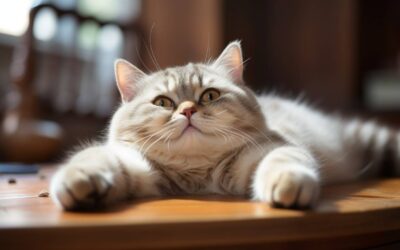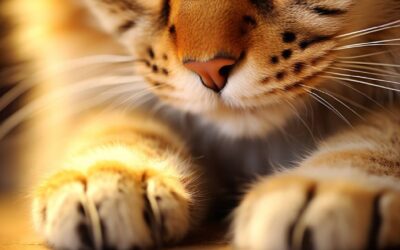Ah, the curious case of cats in heat! If you’ve ever shared your home with a feline friend, you’ve probably encountered this intriguing phenomenon.
In this article, we will dive deep into the world of cats in heat, exploring the signs, frequency, and why spaying is crucial. So, grab your cup of tea, and let’s embark on this journey together!
Signs of a Cat In Heat 🐈💕
Cats are known for their unpredictable antics, but they have a telltale repertoire of behaviors regarding being in heat. These signs might leave you questioning your cat’s sanity.
Yowling
Imagine a moonlit night, a serene ambiance disrupted by a sound that seems to reverberate through the very walls of your home. This haunting yowl, a distinct vocalization, marks the beginning of a cat’s journey into heat.
It’s as though their voice becomes an instrument of desire, echoing their readiness to find a mate. The purpose behind this symphony is primal and instinctual; cats are announcing to the world that they’re available and open for courtship.
Feline Flirtation
If your once-independent cat suddenly becomes the epitome of affection, you might have a feline in heat on your hands. Cats that usually maintain a stoic demeanor can transform into clingy, attention-seeking beings.
They rub against you incessantly, their body language screaming, “Notice me!” This increased affection is a signal to potential suitors and a way for your cat to reassure themselves during this confusing and hormonally charged time.
Scent-sational Marking
Have you noticed your cat rubbing its face against objects with an almost feverish determination? This behavior, known as scent-marking, is another telltale sign of a cat in heat.
By leaving their scent on furniture, walls, and even you, they’re staking their claim and broadcasting their availability to any potential mates, whether real or imaginary. It’s as if they’re creating an olfactory profile that says, “I’m here, and I’m alluring.”
The Frequency of Feline Passion ❤️
In the wild, cats go into heat during warmer months, a strategic alignment with nature’s rhythms that even domesticated felines retain.
Mother Nature’s Influence
Nature has an uncanny way of orchestrating the most intricate rhythms of life, and cats’ heat cycles are no exception. In the wild, where survival depends on the alignment with the seasons, cats tend to go into heat during the warmer months.
This strategic timing increases the chances of successful mating and the subsequent survival of their offspring. Despite domestication, our feline companions retain a connection to this primal rhythm. As the seasons change, so do their hormones, causing heat cycles to synchronize with the natural ebb and flow of the environment.
The Young and the Restless
Cats mature at a rapid pace, a testament to their evolutionary adaptability. Kittens aged 4 to 6 months can experience their first heat cycle. This early onset of fertility might come as a surprise to many cat owners.
However, it aligns perfectly with their wild ancestors’ need to reproduce immediately. As a responsible pet owner, this swift transition to fertility underscores the importance of considering spaying at an early age to prevent unintended pregnancies and support your feline friend’s health.
The Spaying Solution 🕵️
Spaying your cat is a win-win: it helps control the feline population, boosts your cat’s health, and reduces aggression and stress.
Population Control
The responsibility of caring for a cat extends beyond our homes; it encompasses the larger feline community as well. With millions of cats in shelters awaiting homes, spaying is a fundamental step toward reducing overpopulation.
By spaying your cat, you play a pivotal role in controlling the feline population, alleviating the strain on animal shelters, and providing better lives for the cats already seeking homes forever. It’s a small but impactful action that contributes to a more compassionate world for our feline companions.
Health Boost
Beyond population control, spaying offers many health benefits for your furry friend. Female cats spayed have a reduced risk of developing uterine infections and certain cancers.
This preventive measure can significantly increase their lifespan and overall quality of life. As a devoted pet owner, ensuring your cat’s health and well-being is paramount, and spaying is a proactive step that aligns with this commitment.
Reduced Aggression and Stress
Cats in heat are often subject to hormonal fluctuations that can lead to heightened aggression and restlessness. Although a natural part of the cycle, these mood swings can be challenging for the cat and its human companions.
Spaying stabilizes these hormonal shifts, leading to a calmer and more serene temperament. This benefits your cat’s mental well-being and creates a harmonious living environment for everyone involved.
Navigating the Behavioral Challenges Of a Cat In Heat 🐈
Cats in heat come with their fair share of behavioral challenges during the heat. As their human companions, we can provide support and understanding during this transformative phase.
Managing Aggression and Restlessness
Heightened aggression and restlessness can be managed by patience, consistency, and redirecting their energy through interactive play.
Creating a Comfortable Environment
Creating a comfortable and secure environment is vital to help your cat navigate heat challenges. Providing hiding spots, cozy blankets, and interactive toys can offer physical and emotional comfort.
Maintaining Routine
Maintaining routine and reassuring interactions can help alleviate stress and anxiety. Your understanding and support during this time are instrumental in helping your cat feel safe and cared for.
Conclusion
The Journey of a Cat in Heat is a tale of passion etched into the fabric of biology. The chapter is a testament to survival, reproduction, and the unbreakable bond between humans and their feline friends. Every nuance is a page in a story written for eons, from curious behaviors to intricate heat cycles.
So, the next time you hear the yowls of a cat in heat or witness the affectionate rubbing against your legs, remember that you’re an active participant in a saga that spans generations.

FAQs
How long does a cat stay in heat?
A cat’s heat cycle can vary, typically lasting 4 to 10 days. Factors such as breed, age, and environmental conditions can influence the length of this phase.
How often do cats go into heat?
Cats experience heat cycles every 2 to 3 weeks during the breeding season. However, environmental factors can influence the frequency of these passionate episodes.
Do male cats experience heat cycles as well?
Unlike female cats, males do not go into heat cycles. Instead, they are consistently fertile. They may exhibit behavioral changes and heightened interest in female cats in heat, but they do not undergo the same hormonal fluctuations.
Do male cats prefer females in heat over spayed females?
Male cats may be more interested in females in heat due to hormonal cues, but their attraction isn’t solely based on heat status. Social interactions, scent, and other factors also influence their interactions.
What should I do if my spayed cat shows heat-like behaviors?
If your spayed cat displays heat behaviors, it’s a good idea to consult your vet. Occasionally, residual hormonal influences can lead to such behaviors. Your vet can assess the situation and provide guidance.






her first heat cycle been quite experience…
My cat is in heat, and it’s chaos! It’s like living with tornado…